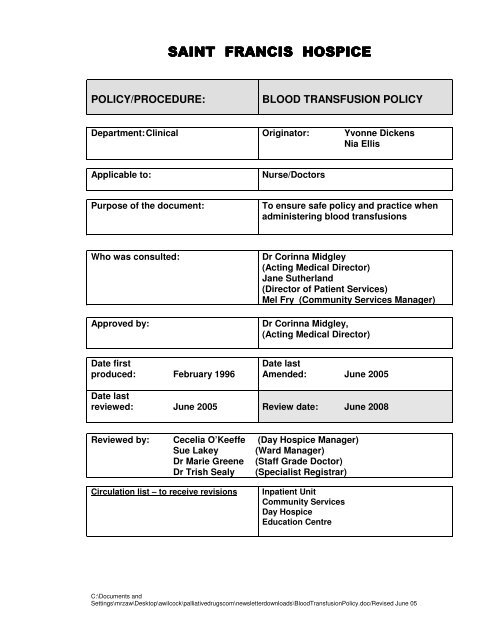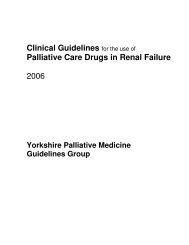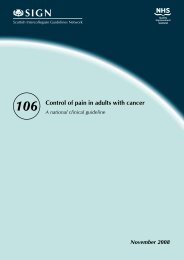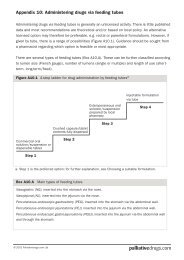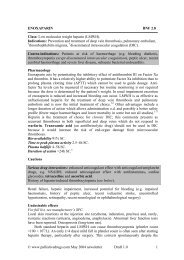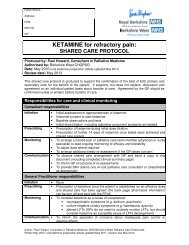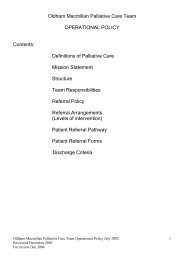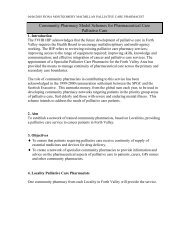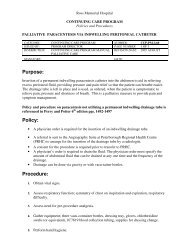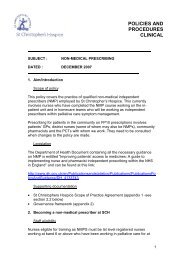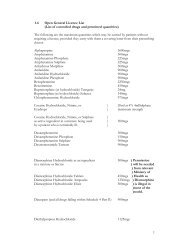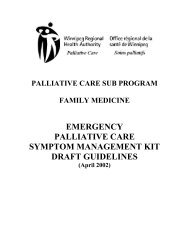Blood transfusion policy - Palliativedrugs.com
Blood transfusion policy - Palliativedrugs.com
Blood transfusion policy - Palliativedrugs.com
Create successful ePaper yourself
Turn your PDF publications into a flip-book with our unique Google optimized e-Paper software.
SAINT FRANCIS HOSPICE<br />
POLICY/PROCEDURE:<br />
BLOOD TRANSFUSION POLICY<br />
Department: Clinical Originator: Yvonne Dickens<br />
Nia Ellis<br />
Applicable to:<br />
Nurse/Doctors<br />
Purpose of the document:<br />
To ensure safe <strong>policy</strong> and practice when<br />
administering blood <strong>transfusion</strong>s<br />
Who was consulted:<br />
Approved by:<br />
Dr Corinna Midgley<br />
(Acting Medical Director)<br />
Jane Sutherland<br />
(Director of Patient Services)<br />
Mel Fry (Community Services Manager)<br />
Dr Corinna Midgley,<br />
(Acting Medical Director)<br />
Date first<br />
produced: February 1996<br />
Date last<br />
Amended: June 2005<br />
Date last<br />
reviewed: June 2005 Review date: June 2008<br />
Reviewed by: Cecelia O’Keeffe (Day Hospice Manager)<br />
Sue Lakey (Ward Manager)<br />
Dr Marie Greene (Staff Grade Doctor)<br />
Dr Trish Sealy (Specialist Registrar)<br />
Circulation list – to receive revisions<br />
Inpatient Unit<br />
Community Services<br />
Day Hospice<br />
Education Centre<br />
C:\Documents and<br />
Settings\mrzaw\Desktop\awilcock\palliativedrugs<strong>com</strong>\newsletterdownloads\<strong>Blood</strong>TransfusionPolicy.doc/Revised June 05
POLICY ON GIVING BLOOD TRANSFUSIONS IN ST FRANCIS HOSPICE<br />
Policy statement:<br />
The role of this <strong>policy</strong> is to help the clinical team clarify which patients may<br />
benefit from blood <strong>transfusion</strong> and how to monitor the out<strong>com</strong>e. It also describes<br />
the procedure in detail.<br />
1. Indications for blood <strong>transfusion</strong>s;<br />
a) symptoms of chronic anaemia e.g. dyspnoea, fatigue.<br />
b) acute blood loss e.g. haemorrhage<br />
c) pre-chemotherapy or radiotherapy<br />
2. Ideally patients should be transfused up to the normal Hb range (i.e. 11-<br />
13g/dl).<br />
Day Hospice<br />
a) The day hospice is limited to a maximum of 2 units per day and,<br />
therefore, a decision as to how many units should be given needs to be<br />
made individually according to the level of anaemia, the likely cause and<br />
the symptoms experienced by the patient.<br />
b) If a <strong>transfusion</strong> of more than 2 units is needed, the patient will have to<br />
attend the Day Hospice on two consecutive days, or be admitted to the<br />
inpatient unit.<br />
c) If the <strong>transfusion</strong> has not been <strong>com</strong>pleted before the staff leave the day<br />
hospice, the patient should be discussed with the inpatient unit staff and<br />
transferred for their supervision.<br />
3. Information to be documented before blood <strong>transfusion</strong> should include<br />
indications for the blood <strong>transfusion</strong>, current symptoms, previous blood<br />
<strong>transfusion</strong>s/ <strong>transfusion</strong> reactions and whether previous <strong>transfusion</strong>s have<br />
been helpful.<br />
4. A doctor must be available on the hospice site for the <strong>com</strong>mencement and at<br />
least the first 20 minutes of each unit.<br />
5. Each unit of blood should be given in 2½ - 3 hours. If it has not been<br />
<strong>com</strong>pleted within 4 hours that unit should be discontinued.<br />
C:\Documents and<br />
Settings\mrzaw\Desktop\awilcock\palliativedrugs<strong>com</strong>\newsletterdownloads\<strong>Blood</strong>TransfusionPolicy.doc/Revised<br />
June 05<br />
1
6. The total <strong>transfusion</strong> should be <strong>com</strong>pleted within 48 hours of the first unit.<br />
7. All details of the <strong>transfusion</strong> should be documented on the <strong>transfusion</strong><br />
record sheet held in the patients notes.<br />
8. Any reactions to a blood <strong>transfusion</strong> should be reported to the medical staff<br />
who will decide what action, if any, needs to be taken.<br />
9. Emergency drugs will be kept available for administration in the event of<br />
any serious reaction following discussion with the doctor. These should<br />
include Piriton, 10mg IV, Hydrocortisone 100mg IV, and Adrenalin 1:1000<br />
IM.<br />
10. Diuretics are not routinely given during a blood <strong>transfusion</strong>, but should be<br />
considered if the patient has any clinical evidence of heart failure. One<br />
Frusemide tablet, 40 mg, is the drug of choice in such situations.<br />
11. <strong>Blood</strong> is currently provided by the Transfusion Department at Harold Wood<br />
Hospital. Arrangements for transporting blood should be made with<br />
the Transport Co-ordinator, who will arrange for a volunteer to collect the<br />
blood.<br />
12. Arrangements should be made, ideally with the referring party, for<br />
assessment between 5 and 7 days after the <strong>transfusion</strong> to assess whether<br />
it has been beneficial i.e. improvement in symptoms, need for a further Hb<br />
check, ongoing monitoring, etc.<br />
C:\Documents and<br />
Settings\mrzaw\Desktop\awilcock\palliativedrugs<strong>com</strong>\newsletterdownloads\<strong>Blood</strong>TransfusionPolicy.doc/Revised<br />
June 05<br />
2
PROCEDURE<br />
1. The blood is transported to the hospice in a blood cool box. This is only to be<br />
opened when removing each unit to ensure that the correct temperature is<br />
maintained. Transfusion should <strong>com</strong>mence within 30 minutes of removal of<br />
the unit of blood from the cool box.<br />
2. The blood <strong>transfusion</strong> record sheet should be <strong>com</strong>pleted. This is also the<br />
prescription sheet for the <strong>transfusion</strong>.<br />
3. The following details should be checked at the patient’s bedside/chair by two<br />
qualified staff (one of whom may be a doctor) for accuracy, using the patient’s<br />
records, unit of blood, blood tag and patient identification bracelet.<br />
• Patient’s full name<br />
• Date of birth<br />
• Hospice record number<br />
• <strong>Blood</strong> group<br />
• <strong>Blood</strong> unit number<br />
• Expiry date<br />
4. To ensure correct patient identification, the identification bracelet should<br />
contain: patient’s full name, date of birth and hospice record number.<br />
5. If there are any discrepancies, contact <strong>Blood</strong> Transfusion at Harold Wood<br />
Hospital to discuss.<br />
6. Observations<br />
a) A baseline observation of <strong>Blood</strong> Pressure, Temperature, pulse and<br />
respirations to be recorded before the <strong>transfusion</strong> <strong>com</strong>mences.<br />
b) The nurse/doctor to stay with the patient for the first 15 minutes of the<br />
<strong>transfusion</strong>.<br />
c) Record observations at 15 minutes from <strong>com</strong>mencement. Severe reactions<br />
usually occur within the first 15 minutes.<br />
d) Continue observations if there is a discrepancy.<br />
7. This procedure will be carried out with each subsequent unit of blood.<br />
8. Staff will check the patient and infusion rate throughout the <strong>transfusion</strong>.<br />
C:\Documents and<br />
Settings\mrzaw\Desktop\awilcock\palliativedrugs<strong>com</strong>\newsletterdownloads\<strong>Blood</strong>TransfusionPolicy.doc/Revised<br />
June 05<br />
3
9. Any adverse reaction must be reported immediately to medical staff e.g.<br />
Temperature – in excess of 1.5°c higher than at the <strong>com</strong>mencement of<br />
<strong>transfusion</strong><br />
Shivering<br />
Rigor<br />
Rash<br />
Flushing<br />
SOB<br />
Pain in extremities or loins<br />
10. At the end of the <strong>transfusion</strong> the line should be flushed with 10-20mls of<br />
normal saline and the IV discontinued.<br />
11. On <strong>com</strong>pletion of <strong>transfusion</strong> final observations should be recorded prior to<br />
the patient going home (day hospice patients and those being discharged<br />
home immediately following <strong>transfusion</strong>).<br />
C:\Documents and<br />
Settings\mrzaw\Desktop\awilcock\palliativedrugs<strong>com</strong>\newsletterdownloads\<strong>Blood</strong>TransfusionPolicy.doc/Revised<br />
June 05<br />
4
NAME DATE OF BIRTH: DIAGNOSIS: HOSPICE NO.<br />
SAINT FRANCIS HOSPICE<br />
BLOOD TRANSFUSION RECORD SHEET<br />
Date: ………………………. Pre-Transfusion Assessment: Assessor’s Name…………..………………………………………………..<br />
Hb g/dl Previous <strong>transfusion</strong> Y / N Transfusion Reactions Y / N<br />
Indication for Transfusion:………………………………………………………………………………………..<br />
Infusion Record<br />
Date Fluid Duration Doctor’s signature Commenced<br />
Name/Signature<br />
Finished<br />
Name/Signature<br />
Special Instructions<br />
Problems during <strong>transfusion</strong>/<strong>com</strong>ments:<br />
Post-<strong>transfusion</strong> assessment (5-7 days after) Date: ……… Assessor’s Name: …………………………………………..<br />
Hb g/dl – if not repeated – why not? ……………………………………………………………………………………………………………………….……………<br />
Symptoms improved Y / N Comments: ……………..……………………………………………………………...............................................................<br />
Is it appropriate to consider further <strong>transfusion</strong>s? Y / N Rationale for decision: ...............................................................................................................<br />
Arrangements for further follow-up: …………………………………………………………………….<br />
Date: Hb g/dl Date: Hb g/dl<br />
C:\Documents and Settings\mrzaw\Desktop\awilcock\palliativedrugs<strong>com</strong>\newsletterdownloads\<strong>Blood</strong>TransfusionPolicy.doc/Revised June 05


